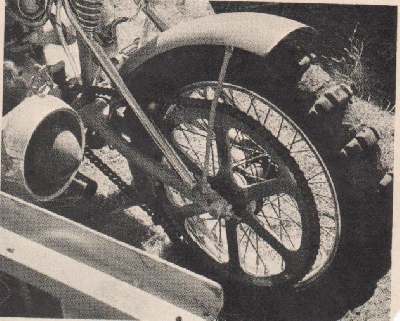¶ Motorcycles use chain because it is a very efficient way to transfer power from the transmission to the rear wheel. In the old days rear chains were totally enclosed and
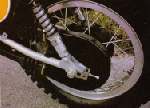 sometimes run in an oil bath. These chains lasted a long time. Sometimes as much as 40,000 miles or more. These days we gotta look trick so no more enclosed chain. This means you have to lube the chain a lot more often. I would say you need to lube a chain with a good chain lube a minimum of once every time you fill the gas tank. Once an hour would be better. Most of my customers lube their chains, Oh... about once a year. That might be optimistic I think.
sometimes run in an oil bath. These chains lasted a long time. Sometimes as much as 40,000 miles or more. These days we gotta look trick so no more enclosed chain. This means you have to lube the chain a lot more often. I would say you need to lube a chain with a good chain lube a minimum of once every time you fill the gas tank. Once an hour would be better. Most of my customers lube their chains, Oh... about once a year. That might be optimistic I think.
As a result most chains and sprockets are worn out in less than a thousand miles. Usually, when the chain is worn out so are the front and rear sprockets. This is because a chain does not "stretch" as it wears. It becomes elongated due to wear in the joints. This changes the pitch, which in turn wears out the sprockets. I have seen some big bikes, with big 630 chain, that seem to have worn out their chains without wearing out their sprockets too much. They were all well oiled all the time, they had big, low power engines AND I haven't seen very many of them. The biggest chain tip I can give is to oil that chain all the time. You can't do it too much.
In the old days, you would take the chain off, clean it off real good in solvent with a tooth brush and put it in a pan of grease. Put the pan on the stove and melt the grease so it will penetrate the bearing area, in the links of the chain. That's still a great way to really lube that chain, however, no one today will ever take the time to do it. 90 weight gear oil works good too, but it does tend to fly off. Fortunately, we have lots of different chain sprays on the market that work great. They go on as a liquid and penetrate the chain rollers, then dry, leaving the grease behind. The drill is to spray it on good and heavy, while spinning the wheel. Try to spray the edges of the chain. Now let it set for 10-15 minutes and you are good to go.
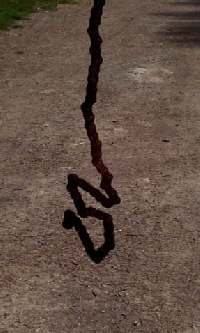
Now, I know what you are going to say. "I've got an O-Ring Chain. The ad said I don't have to lube it." Well, How do you define "Lube"? The picture to the left is of an O-Ring chain I took off a customers bike. Believe it or not, this is not the worst I've seen. One customer brought in an O-Ringed chained bike(XR200R Honda) and I could barely push it into the shop. You can't tell me that's not soaking up some horse power. The moral of the tale is this. Lube your chain even if it's an O-Ring chain. Just to complicate things, make sure the lube is OK for O-Ring chains.
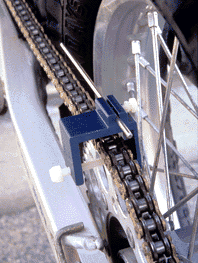 A chain must be adjusted from time to time. Both front and rear sprockets must be in line with one another, otherwise the chain will wear more on one side than the other. To help in this there are marks on each side of the swingarm. Simply match the marks. Yes, it is true the marks may be off, but I don't think they are as far off as some people say. If it bothers you that much, look down the chain and see if it going to one side or the other. Adjust it so it tracks straight. There are tools, like the one to the right, that you can use to help. When adjusted right the chain will have 1/2" or so, up and down play in the center between the sprockets. This is for bikes with normal shock travel. If you have a long shock travel bike (most dirt bikes) this play may be as much as 1 1/2". Check you shop manual for the correct amount.
A chain must be adjusted from time to time. Both front and rear sprockets must be in line with one another, otherwise the chain will wear more on one side than the other. To help in this there are marks on each side of the swingarm. Simply match the marks. Yes, it is true the marks may be off, but I don't think they are as far off as some people say. If it bothers you that much, look down the chain and see if it going to one side or the other. Adjust it so it tracks straight. There are tools, like the one to the right, that you can use to help. When adjusted right the chain will have 1/2" or so, up and down play in the center between the sprockets. This is for bikes with normal shock travel. If you have a long shock travel bike (most dirt bikes) this play may be as much as 1 1/2". Check you shop manual for the correct amount.
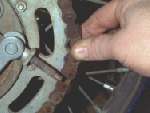 You can tell if the chain is worn by pushing up on the chain in the middle (between the sprockets) with one hand, while pulling on the chain at the rear sprocket. If you can pull the chain out from the sprocket much at all, say 1/4" or more, the chain is worn out. Another way is to measure the total length of the chain, when new, and replace it when it has lengthened by 2 1/2 %. You will also find that a worn chain is hard to adjust because some spots will be tight and others loose. You will want to adjust the chain slack when the chain is at its tightest. If you find that the chain has stretched so much that there is no more adjustment, simply take out two rollers. This is very GROSS but it is effective. You normally have to remove them in pairs. Sometimes, you can get a special link that adds only one roller. In other words take out two rollers and add one, to shorten the chain by one roller.
You can tell if the chain is worn by pushing up on the chain in the middle (between the sprockets) with one hand, while pulling on the chain at the rear sprocket. If you can pull the chain out from the sprocket much at all, say 1/4" or more, the chain is worn out. Another way is to measure the total length of the chain, when new, and replace it when it has lengthened by 2 1/2 %. You will also find that a worn chain is hard to adjust because some spots will be tight and others loose. You will want to adjust the chain slack when the chain is at its tightest. If you find that the chain has stretched so much that there is no more adjustment, simply take out two rollers. This is very GROSS but it is effective. You normally have to remove them in pairs. Sometimes, you can get a special link that adds only one roller. In other words take out two rollers and add one, to shorten the chain by one roller. Chain is always measured in rollers. Now that we are talking about chain and sprocket wear, the question arises... how much is too much?
Chain is always measured in rollers. Now that we are talking about chain and sprocket wear, the question arises... how much is too much?
If you are removing rollers, you are already well past the "Worn Out" stage and into the "Total Garbage" stage. But, how much is too much? To get the answer, we need to consider several things. How much horse power do we have? If the bike has a lot of suds the danger of chain breakage goes way up. When a chain brakes, it normally shoots one end through the crankcase.
This can be quite expensive. If the chain jumps off the sprocket it can lock up the rear wheel. If you are going really fast, shoot, even if you are not going fast, this can be very exciting. Also painful. If you are willing to live with the breakage and lockup risk, you can run the chain and sprockets untill the teeth get bent and rounded so bad the chain jumps teeth on the sprocket. Now, this is not the best thing to do but it can be done. Is there some sort of steel chain guard in front of the sprocket? This could protect the crankcase in the event of a chain failure. Could you make one? Is your health insurance paid up? All in all, the best thing to do is replace the chain and sprockets and then keep them well oiled.
But, back to the question of how far can you push it. Bob Lane sent me this picture from England and said...
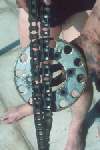 "Back in 1981, 3 of us set off from England for a 2-week touring ride around mainland Europe. I was on my T150V Triumph Trident and the other 2 had Z1000 Kawasakis.
Before departing, giving more thought to the fact that we would only be away from home for 2 weeks rather than the fact that we would be putting in some serious mileage, one of the guys decided that with a fairly worn rear drive chain, he would remove a link to provide more adjustment should he need it. 5 days and 2500 miles later in Athens (yes, Greece!) the photograph shows the result. As you can imagine, the last 300 miles or so, were only achieved by tightening the chain to provide friction drive with what was left of the sprocket. Indeed, such was the strain on the chain, that the rollers had flats worn on them by the time we arrived at our final holiday destination.
".
"Back in 1981, 3 of us set off from England for a 2-week touring ride around mainland Europe. I was on my T150V Triumph Trident and the other 2 had Z1000 Kawasakis.
Before departing, giving more thought to the fact that we would only be away from home for 2 weeks rather than the fact that we would be putting in some serious mileage, one of the guys decided that with a fairly worn rear drive chain, he would remove a link to provide more adjustment should he need it. 5 days and 2500 miles later in Athens (yes, Greece!) the photograph shows the result. As you can imagine, the last 300 miles or so, were only achieved by tightening the chain to provide friction drive with what was left of the sprocket. Indeed, such was the strain on the chain, that the rollers had flats worn on them by the time we arrived at our final holiday destination.
".
Always replace the chain and front and rear sprockets as a set. Never mix used parts with new parts. Yes, I know there may be rare exceptions to this rule (like big, well maintained, street bikes) but they are few and far between. It seems to be Ok to replace used with used because everything is ... well used.
To replace the chain and sprockets, first remove front chain guard and the front sprocket keeper. Most front sprockets are held on by one of three ways. With a E-clip, a big nut and lock washer, or with a clip that is bolted to the sprocket. The E-clip is a down and dirty way that is used for quick sprocket removal. A big "E" clip is used to hold the front sprocket on. Just pop it off and pull off the sprocket. This actually works pretty good but is not as secure as the other ways and usually means some one has replaced the factory keepers because not too many factories use this method to retain the sprocket. 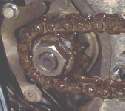 The big nut keeper uses a big nut (Well DUH !) and a special lock washer. The lock washer fits over special teeth machined in the counter shaft. These keep it from turning. Then part of the washer is bent over one of the flats on the nut, keeping it from turning. The big nut will have an indention or groove cut in one side. This goes toward the sprocket.
The big nut keeper uses a big nut (Well DUH !) and a special lock washer. The lock washer fits over special teeth machined in the counter shaft. These keep it from turning. Then part of the washer is bent over one of the flats on the nut, keeping it from turning. The big nut will have an indention or groove cut in one side. This goes toward the sprocket.
The Bolted Clip type fits in grooves on the counter shaft and then twists and bolts to the sprocket with two bolts. It is easiest to remove these bolts or nuts when the chain is still on so that it will hold the sprocket. If the sprocket still turns, you may have to get someone to hold the rear brake on while you unscrew things.
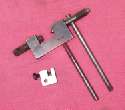 Now we take the chain off. Spin the tire around untill you find the master link and gently pop the clip off. Even if you are replacing the chain, save the clip and put it in the tool kit you carry on the bike. You never know, but you might need it some day. If the chain is endless you will need to break it. The best way is to use a chain breaking tool. Another way, is to put a grinding wheel in a drill and grind the ends of the chain link rivets flush with the link side plate. Then knock the rivet out with a punch. Gross, but effective and cheap.
Now we take the chain off. Spin the tire around untill you find the master link and gently pop the clip off. Even if you are replacing the chain, save the clip and put it in the tool kit you carry on the bike. You never know, but you might need it some day. If the chain is endless you will need to break it. The best way is to use a chain breaking tool. Another way, is to put a grinding wheel in a drill and grind the ends of the chain link rivets flush with the link side plate. Then knock the rivet out with a punch. Gross, but effective and cheap.
After the chain is off, remove the rear wheel. The rear sprocket is usually bolted to the rear hub. Sometimes it is bolted to a sprocket carrier, which slides into rubber cushions in the hub. Don't lose the nuts or bolts or lock washers. Often, they are of a special length or design. Now is a good time to look at any chain guides on the swing arm or chain slack adjuster rollers for wear and replace them if necessary.
 Bolt everything back together. If the sprocket is of a dished type, make sure it goes on the right way. Put it on backwards and things wear really quick. Please don't ask how I know this... trust me, it can be done and it does wear quickly. Don't forget to bend over the locking tabs if there are any. Sometimes it helps to have a special tool to hold the chain ends together. 530 and 630 chain master links can be a very tight fit so it helps to have a chain press to press the side plate on with. You can also use a set of vice grips of the right size. If you are using a clip type master link make sure the closed end is pointed in the direction the chain travels. Rivet links need a chain riveter. At least that's the easiest way. You can also ping the rivet end over with a punch and hammer if you back up the master link with a big sledge hammer or piece of heavy metal.
Bolt everything back together. If the sprocket is of a dished type, make sure it goes on the right way. Put it on backwards and things wear really quick. Please don't ask how I know this... trust me, it can be done and it does wear quickly. Don't forget to bend over the locking tabs if there are any. Sometimes it helps to have a special tool to hold the chain ends together. 530 and 630 chain master links can be a very tight fit so it helps to have a chain press to press the side plate on with. You can also use a set of vice grips of the right size. If you are using a clip type master link make sure the closed end is pointed in the direction the chain travels. Rivet links need a chain riveter. At least that's the easiest way. You can also ping the rivet end over with a punch and hammer if you back up the master link with a big sledge hammer or piece of heavy metal.
That's about it. Lube it up and you are done.
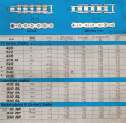 Chain comes in a number of sizes. The more power a bike puts out the bigger the chain. Sometimes the next grade up in strength is just a wider chain. 428 and 428H are the same pitch, but 428H is a bit wider and stronger. 520,
Chain comes in a number of sizes. The more power a bike puts out the bigger the chain. Sometimes the next grade up in strength is just a wider chain. 428 and 428H are the same pitch, but 428H is a bit wider and stronger. 520,  525 and 530 are like that too. Pitch is the distance between two roller centers. Having the same pitch means they will all fit on the thinner sprocket. 520, 525, and 530 will all fit on a 520 sprocket, but a 530 sprocket will only fit 530 chain. So if there is the side clearance, a bigger chain will sometimes fit. Just to make things fun, Suzuki came up with an odd ball chain size called 532. It's a good idea no one seems to like. This chain is lighter than a 630 but stronger than a 530. I've only found Suzuki to use it on some of their bikes, no one else does. It can be hard to find. EK makes it and somebody else too, but I forget who.
525 and 530 are like that too. Pitch is the distance between two roller centers. Having the same pitch means they will all fit on the thinner sprocket. 520, 525, and 530 will all fit on a 520 sprocket, but a 530 sprocket will only fit 530 chain. So if there is the side clearance, a bigger chain will sometimes fit. Just to make things fun, Suzuki came up with an odd ball chain size called 532. It's a good idea no one seems to like. This chain is lighter than a 630 but stronger than a 530. I've only found Suzuki to use it on some of their bikes, no one else does. It can be hard to find. EK makes it and somebody else too, but I forget who.
O-ring chains are a good idea, but they cost more. Some just have a regular O-ring and some have fancy styles of O-rings with special grooves for extra lube. Remember... YOU HAVE TO LUBE THEM!
You can get the rear sprockets in either aluminum or steel. Both wear well if lubed often. Steel is cheaper but weights more and comes in fewer sizes. Aluminum is light weight and comes in a lot of sizes, but costs a lot more than steel. Front sprockets come only in steel... well, there might be a few aluminum ones, but I can't think of any.
When you get new sprockets, you might want to consider changing gear ratios. This can really help the bike be more enjoyable to ride. For example, if you want to lower your engine RPM at highway cruising speeds you can either get a bigger (more teeth) front sprocket or a smaller (fewer teeth) rear sprocket. If you need more power up through the gears on a dirt bike, you can get a bigger rear sprocket or a smaller front sprocket. Generally speaking, one tooth change on the front sprocket equals about a 3 1/2 tooth change on the rear sprocket. It's best to keep the front sprocket as big as possible to lessen chain velocity as the chain rounds the sprocket, however it is cheaper to change the front sprocket as opposed to changing the rear. Bottom line... if your bike has trouble climbing that hill, (not enough power) go one tooth smaller on the front (counter shaft) sprocket. If it revs too high in top gear... just won't go fast (MPH) enough... go up one tooth on the front sprocket.
You can download a nice Free little program to figure out Motorcycle gear ratios from the IronJungle.
Download GearCalc v3.012 for Windows (244K zip file)
Here
For an online gear ratio calculator try Here



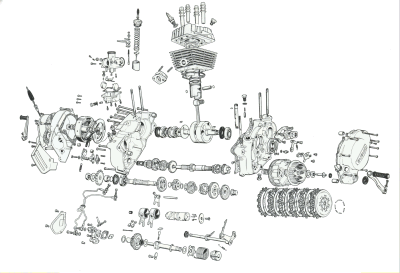 |
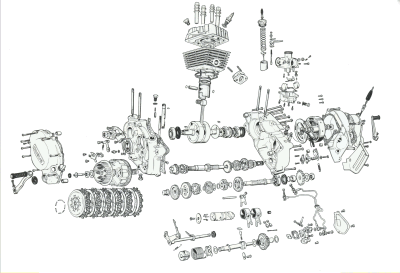 |
Copyright © 1999-2004 dansmc.com. All rights reserved.
